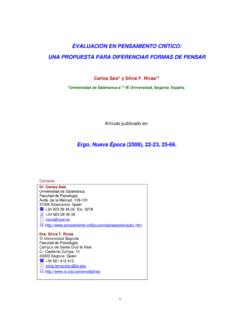Transcription of VALIDATION AND PSYCHOMETRIC PROPERTIES OF THE …
1 Departamento de Psicolog a B sica, Psicobiolog a y Metodolog a de las Ciencias del Comportamiento FACULTAD DE PSICOLOG A. VALIDATION AND PSYCHOMETRIC PROPERTIES . OF THE PENCRISAL CRITICAL THINKING TEST. Silvia F. Rivas & Carlos Saiz Published in: Rivas, and Saiz, C. (2012). VALIDATION and PSYCHOMETRIC PROPERTIES of the PENCRISAL. critical thinking test. Revista Electr nica de Metodolog a Aplicada. (Electronic Journal of Applied Methodology.) Vol. 17 (1), 18-34. ( ). Contact information: Sivia F. Rivas and Carlos Saiz Universidad de Salamanca Facultad de Psicolog a Avda. de la Merced, 109-131. 37005 Salamanca. +34 923 29 45 00. Ext. 3278. +34 923 29 46 08. 2. VALIDATION AND PSYCHOMETRIC PROPERTIES . OF THE PENCRISAL CRITICAL THINKING TEST. Silvia F. Rivas & Carlos Saiz Universidad de Salamanca Descriptors: critical thinking, evaluation, reliability, validity, factor analysis Abstract The purpose of our study was to validate the critical thinking test PENCRISAL.
2 In the Spanish population. This test is an appropriate tool to assess reasoning skills (of various kinds, such as argumentation, causal reasoning, analogical ), problem solving and decision making. The PSYCHOMETRIC study was conducted with a sample of 715 Spanish adults, with college cultural level, aged between 18 and 53, and of both sexes. Reliability in terms of internal consistency achieved an acceptable level, if we consider the complexity of the theoretical model of the construct is under critical thinking (Cronbach alpha: ,632). In turn, the reliability in terms of temporal stability, according to the test-retest method, this has proven to be high (r = ,786). And finally, the reliability between judges has reached a high level of agreement between the correctors (Kappa values between ,600 - ,900).
3 Factor analysis has shown a number of factors and subfactors that fit the theoretical model proposed and the results we obtained from the correlations with other tests support the divergent validity, but not convergent. The PENCRISAL is presented as a novel instrument, validated for a Spanish population, whose results show high accuracy and effectiveness as an instrument for measuring the factors that make up the construct of critical thinking. 1. INTRODUCTION. There are many ideas on critical thinking, and we must specify which one we advocate. Our thesis is that people reason and make decisions to solve problems or achieve goals. Within this approach we conceive critical thinking as a theory of action. Critical thinking is not merely going more deeply into good judgement and argumentation.
4 It is essential that this reflection prove that critical thinking serves to solve problems or achieve goals, thus considering the argument as a means, not an end. We conceive of critical thinking as an action that leads us to implement our plans. From this perspective, critical thinking rests on three fundamental skills: reasoning, problem solving and decision making. Thinking must change reality, not just our ideas, it must do more than produce knowledge, it must solve problems. The applied aspect of critical thinking ends in action, effectively solving problems and making sound decisions. Good reflection is essential for this. Therefore, reasoning, deciding and resolving should be considered as inseparable thought mechanisms that are dependent on each other. Good reflection can design a good action plan that is executed with good decision-strategies and problem-solving.
5 3. The need and importance of assessing critical thinking in everyday life come from the social or personal desire to improve these skills. To know whether such an improvement exists requires accurate quantification. Thus, the reason for developing the PENCRISAL test stems from the need to evaluate the ARDESOS intervention program we conducted in this area (Saiz and Rivas, 2011) and the lack of suitable instruments. The main difficulties in the assessment of critical thinking are both conceptual and methodological. The former arise from the diversity in conceptualising critical thinking. The latter mostly originate from the fact that the tests for measuring critical thinking (Ennis, 2003) are closed response format instruments, which prevent the exploration of the fundamental mechanisms of thought involved in the task of responding to a test.
6 The HCTAES test (Halpern Critical Thinking Assessment Using Everyday Situations;. Halpern, 2006) overcomes this difficulty. This instrument focuses on the thought processes; the items proposed in the test are situations that describe everyday problems that must be resolved through open and closed answers. Our PENCRISAL test stems from this author's approach. We have kept some of her principles, but we have modified some that are not very suitable (Saiz and Rivas, 2008). The principles underlying our test are: 1) the use of everyday situations as items, 2) the use of different domains, in order to assess the degree of generalization of skills, 3) an open answer format that facilitates the exploration of the thought processes, and 4) the use of problem situations with single response that enables the corresponding thought mechanism to be evaluated and facilitates the quantification of the items (see also Rivas and Saiz, 2010).
7 The aim of this study is the VALIDATION of the PENCRISAL Critical Thinking test in the Spanish population. 2. METHODOLOGY. Development of the instrument and procedure In a first phase, an extensive bank of items was prepared in order to have a wide selection available. This first version of the test was applied in a pilot test on a sample of 469 university students from different backgrounds, with the goal of completing the PSYCHOMETRIC analysis of the items. From these analyses, we discarded those items that did not provide the PSYCHOMETRIC PROPERTIES needed to remain in the final scale, replacing them with new items and reworking those that could still achieve the PROPERTIES required. Based on these results, we developed a second version, which was applied to a sample of 313 university students.
8 Factor analysis on the results of the PSYCHOMETRIC study showed a set of factors and sub-factors that explained of the total variability. Most of the items (80%) showed they belonged to the expected theoretical factors. In general terms, it can be considered that the scale was already showing good results. This analysis allowed us to make the changes necessary to adjust the PROPERTIES of the items, primarily to reduce the very high rate of difficulty of some items, and improve the items' fit to theoretical factor model (Saiz and Rivas, 2011). This study is part of the third phase of the research, which presents the VALIDATION of the third version of the test. Characteristics of the instrument PENCRISAL is a test consisting of 35 situations-problems that require an open response.
9 The statements are designed so they do not require the response to be 4. developed and expressed in technical terms but, on the contrary, responses can be easily written in everyday language. These 35 items are configured around five factors: deductive, inductive and practical reasoning, decision making, and problem solving with 7 items per factor (see Annex I). The selection of the most characteristic structures was taken into account in the distribution of situations-problems in each factor. These factors represent the fundamental skills of critical thinking, and within each of them, we find the most relevant ways of reflecting on and resolving issues in our daily activities. The items were presented in random order. The PENCRISAL test could be done on pencil and paper in group; however we opted to use a computerized test, completed individually over the internet, as this system offered most benefits.
10 These benefits are for the judges, as it facilitates the tedious task of dumping data, as well as for the person performing the test because the system allows the test to be taken in several sessions, the possible effects of fatigue may occur in the person performing the test are reduced, particularly in the performance of the latter items. The system also allows control of all relevant aspects of the test, such as impeding entry of blank items and also provides the opportunity to correct replies or take the test again after completing it. The Internet version allows participants to perform the test anywhere there is a connection to the Net. Other advantages of online data collection are well known and we will not dwell on them. Therefore, applying the test over the Internet seems the most suitable way.








![Abstract arXiv:1802.01561v3 [cs.LG] 28 Jun 2018](/cache/preview/8/e/0/5/3/8/0/0/thumb-8e053800553cda3e85d8eff684e96419.jpg)